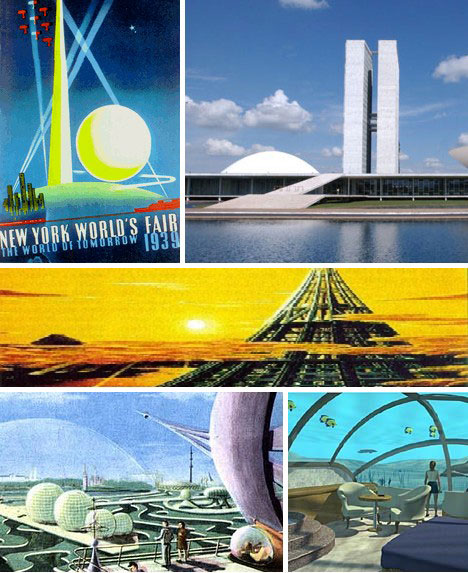
Urban planners, sociologists and science fiction writers have long dreamed of futuristic utopias at sea, on land or in space. These 10 examples showcase some of the weird, wild, and workable plans for living tomorrow’s lifestyle today.
Brasilia: Welcome to the Concrete Jungle
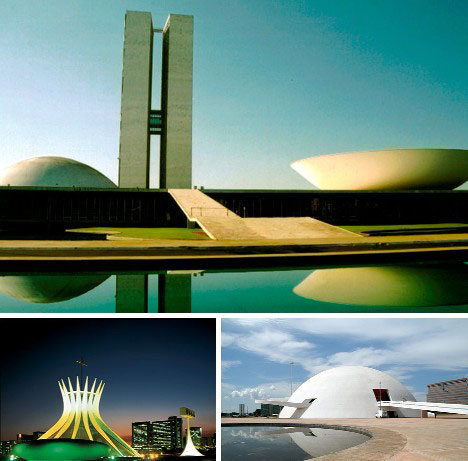 (images via: About Brasilia and Design Hotels)
(images via: About Brasilia and Design Hotels)
When Brazil’s leaders decided they had to move the nation’s center of government from overcrowded, overbuilt and overly distracting Rio de Janeiro, they decided to start from scratch. The result: Brasilia! Forward-thinking architects like Oscar Niemeyer were contracted to design grand public buildings suitable for the Space Age while Brazilian native son and renowned urbanist Lucio Costa laid out wide, open spaces and green expanses very different from those of long established cities.
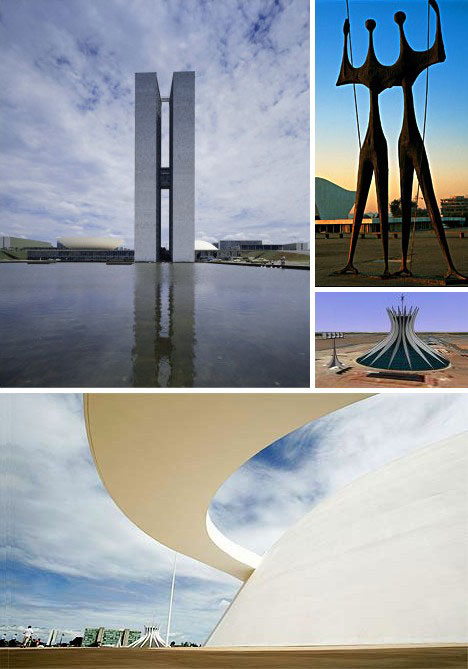 (images via: Guardian UK and Allposters)
(images via: Guardian UK and Allposters)
When Brasilia was completed in 1960 it was a wonder to behold. It was also silent… the city’s stark, ultra-modernist design left out one essential ingredient: people. Those who had to live in Brasilia felt a crushing sense of alienation. Dwarfed by the imposing, sterile buildings and frustrated by the yawning spaces between them, citizens quickly realized the future wasn’t golden; instead it was tinted the drab gray of reinforced concrete.
Paris Becomes the City of Light
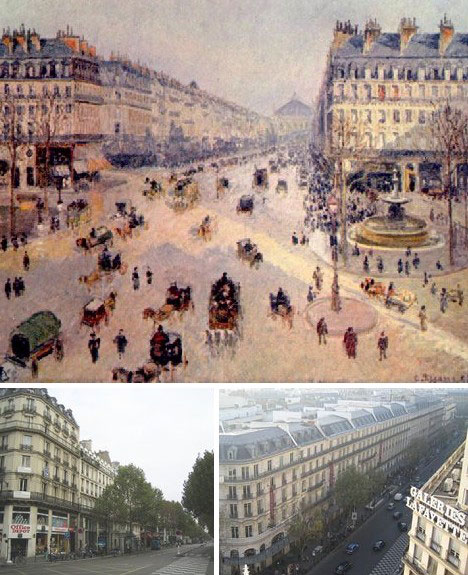 (image via: Art History Archive)
(image via: Art History Archive)
Perhaps the builders of Brasilia should have looked back before moving ahead on their clean slate plan. Just over a century earlier, French emperor Napoleon III was mulling over ways to remake Paris. Recalling the chaos that ensued when rebels blocked off streets during the 1848 revolution, Napoleon called upon the city prefect, Baron Georges-Eugène Haussmann, to undertake a grand remodeling project whose initial phase alone would last almost 20 years.
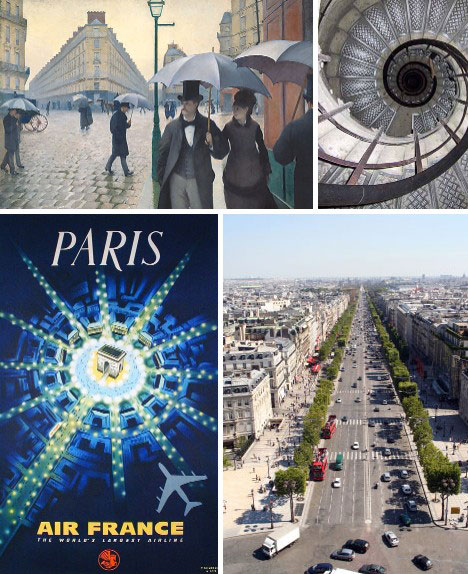 (images via: Everywheremag and Gothereguide)
(images via: Everywheremag and Gothereguide)
The overarching purpose of the plan was to ease access by the military, and that involved widening the main streets. Beginning in 1852, “Haussmannisation” inexorably turned Paris from a dense warren of narrow, twisting medieval alleys into the City of Light we know today. Although renovated Paris was indeed much more open and manageable, it remained a city OF the people, not FOR the people.
Dongtan: Metapolis or Mistake?
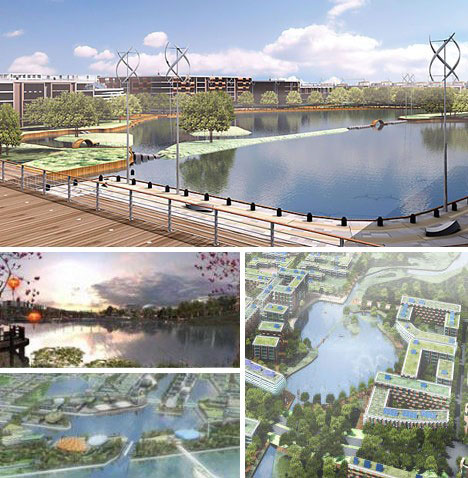 (images via: CSMonitor and Thomasnet)
(images via: CSMonitor and Thomasnet)
Today, the ideal cities on the drawing board have decidedly green blueprints. Case in point: Dongtan, an ambitious development near Shanghai, China, expected to be half the size of Manhattan and home to a half-million residents by 2010. That may not happen – the world financial crisis has put a crimp into many large scale plans and Dongtan has been delayed.
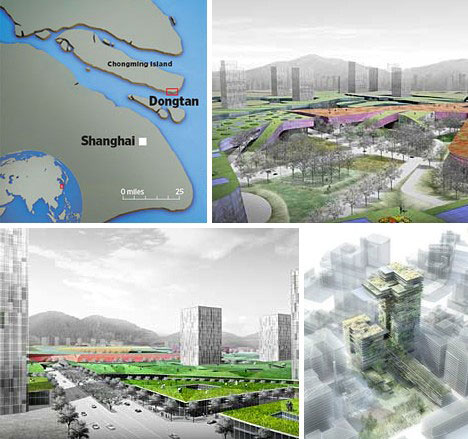 (images via: Marukuwato and Asia Clean Tech)
(images via: Marukuwato and Asia Clean Tech)
Designed as a showpiece for China’s concern for the environment, Dongtan was planned from the get go to be eco-friendly and environmentally sustainable. Originally, the only cars to be permitted within the city limits had to be electric or otherwise non-polluting – this requirement has been relaxed in the interest of practicality. It will be interseting to see just how much of the architects’ vision will be realized when – or IF – Dongtan is eventually completed.
Masdar City – Zero Carbon, Zero Emissions, Zero Cars
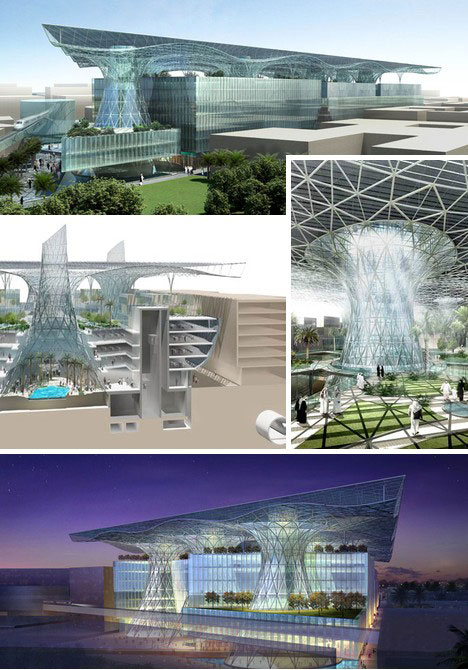 (image via: Jetson Green)
(image via: Jetson Green)
Dubai, home of many of the world’s most interesting architectural projects, is going green with Masdar City. Zero carbon, zero emissions, zero cars… and if that’s not enough zeros for you, check out the price tag: $22,000,000,000!
 (image via: Inhabitat)
(image via: Inhabitat)
One of the most exciting buildings planned for Masdar is the centerpiece of the city, the 1.4 million square foot Headquarters. Going beyond mere energy self-sufficiency, the Masdar Headquarters will be the world’s first mixed-use, net positive energy building. A huge photovoltaic array on the roof will generate more energy each day than the building consumes – in fact, the roof will be constructed first, thus allowing it to generate the energy used in assembling the rest of the Headquarters.
X-SEED 4000 – Peak at the Future
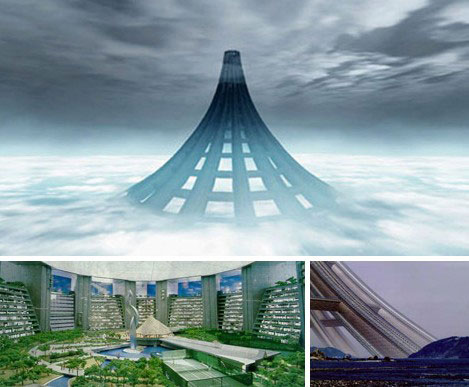 (image via: Naturetm)
(image via: Naturetm)
Sometimes designers get a little carried away, and this is one of those times. The X-Seed 4000… the “4000” refers to its height of 4,000 meters (about 13,150 feet!), which would dwarf any other man-made structure while housing an estimated one million people. The base of this artificial Mount Fuji would be about 6 miles wide. Impressive yes, but around 35 of them would be needed to absorb the current population of Tokyo where the project is set to begin construction, er, some day.
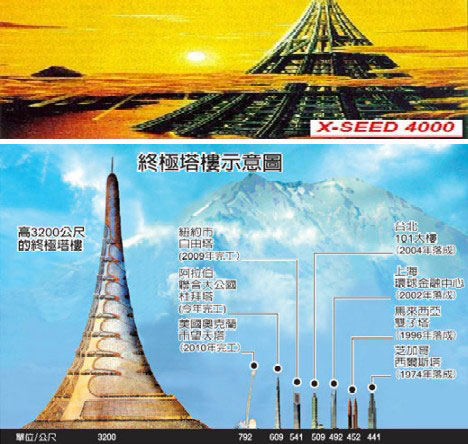 (images via: Satrun3000 and Inhabitat)
(images via: Satrun3000 and Inhabitat)
Considering the estimated $300-900 billion dollars required to actually build the X-Seed 4000 and we won’t even get into the physical problems – such as temperature and pressure differentials between the uppermost floors and the base – we can safely assume that both the X-Seed 4000 and the 2-mile high Ultima Tower shown above are merely design studies intended to bring attention to their designers. In that respect, they have been towering successes.
Crystal Island, Moscow on the Awesome
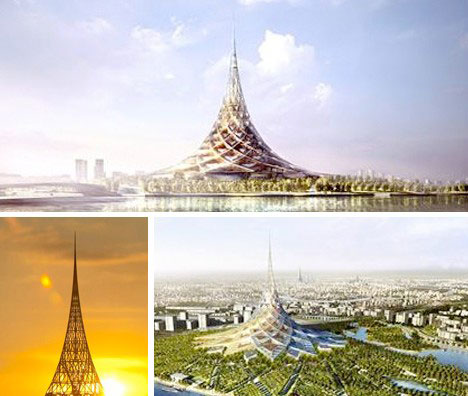 (images via: Geekabout and Foster + Partners)
(images via: Geekabout and Foster + Partners)
Crystal Island is another giga-project that, though granted planning approval, may never progress to the bricks & mortar stage. The plans themselves are quite formidable, calling for a total floor area four times that of the Pentagon, 900 apartments able to house up to 30,000 people, and a 500-student international school.
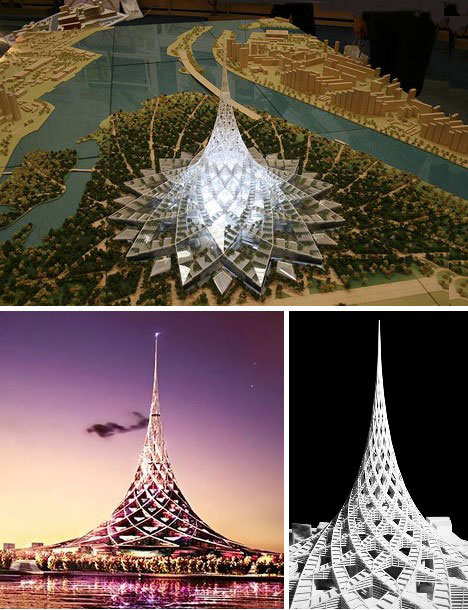 (images via: Elite Choice and Zcorp)
(images via: Elite Choice and Zcorp)
Situated on the Nagatino Peninsula just over a mile away from the Kremlin, Crystal Island will soar 1,500 feet into the sky and will offer incredible views of Moscow from observation platforms at the 980 foot level.
EPCOT: Mickey Mouse Idea?
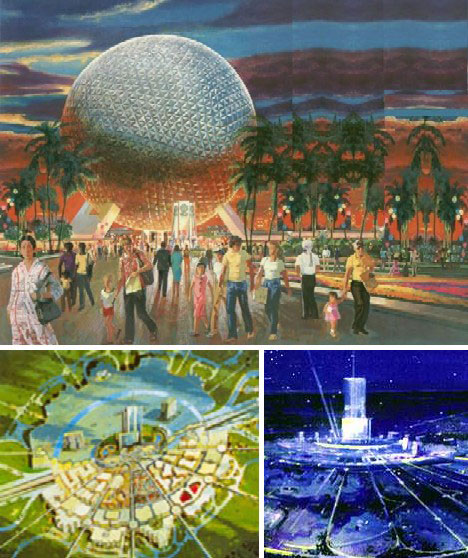 (images via: Plan A Magical Vacation and Spyhunter007)
(images via: Plan A Magical Vacation and Spyhunter007)
Any review of futuristic cities must make mention of EPCOT, Walt Disney’s “Experimental Prototype City of Tomorrow” at Orlando, Florida’s Disney World. Take it away, Walt: “EPCOT will take its cue from the new ideas and new technologies that are now emerging from the creative centers of American industry. It will be a community of tomorrow that will never be completed, but will always be introducing and testing and demonstrating new materials and systems. And EPCOT will always be a showcase to the world for the ingenuity and imagination of American free enterprise.”
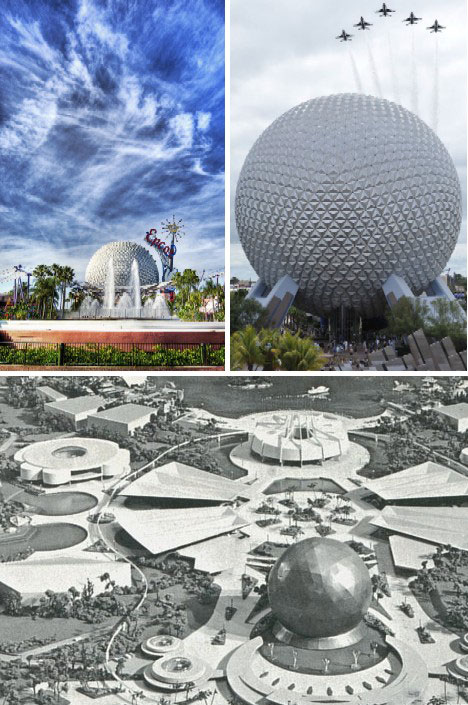 (images via: Stuck In Customs, Disneypix and Orlando Sentinel)
(images via: Stuck In Customs, Disneypix and Orlando Sentinel)
Opened to great fanfare in 1982, EPCOT is dominated by a huge geodesic dome of the type pioneered by famed futurist Buckminster Fuller which surrounds Spaceship Earth.
I’d Like to Be, Under the Sea
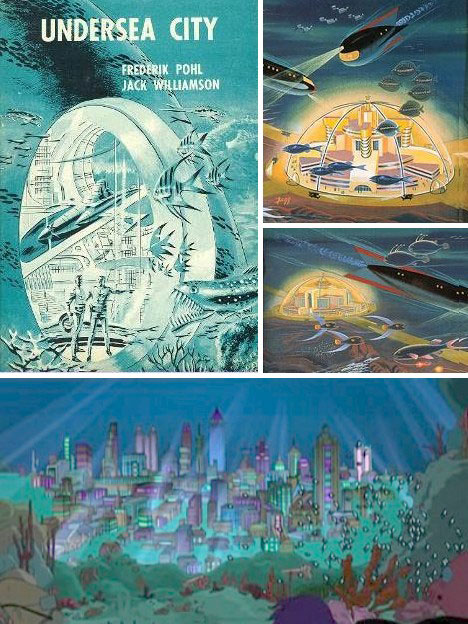 (images via: The Function Key and Fantastic Fiction UK)
(images via: The Function Key and Fantastic Fiction UK)
As Earthly real estate becomes more and more crowded, the only where to go is up to the sky or down to the floor: the ocean floor. Ideas for undersea range from serious to humorous (such as Futurama’s sunken Atlantis cum Atlanta) but the main question confronting futurists is not so much How, but When?
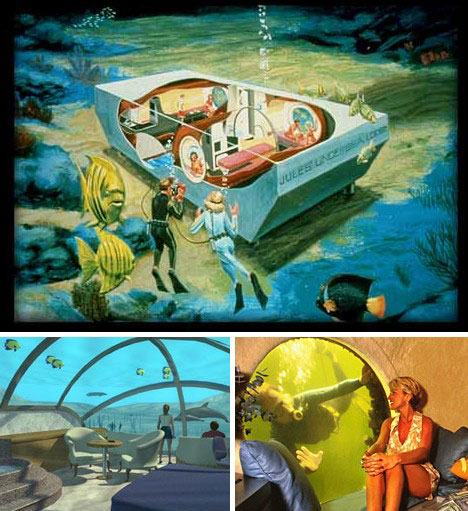 (image via: Jul.com)
(image via: Jul.com)
In fact, people ARE living on the ocean floor, though it’s not 20,000 leagues under the sea… just 20 feet. Jules’ Undersea Lodge is an underwater hotel where guests (who have included former Canadian prime minister Pierre Trudeau and Aerosmith frontman Steven Tyler) enjoy an oceanic overnight stay while remaining high and dry. Unless they open the window, that is.
The Build Up to the Build Up
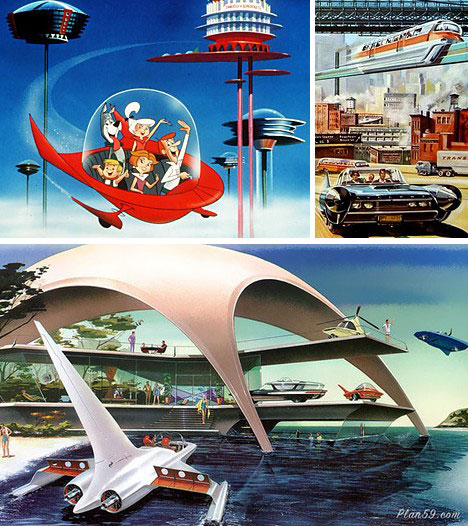 (images via: News.com.au and Dark Roasted Blend)
(images via: News.com.au and Dark Roasted Blend)
Futuristic cities have been described by pretty much everyone from sci-fi illustrators to Hanna-Barbara, but just how practical would Jetsons-style sky cities really be? Does it matter? In the spirit of 1950s optimism, let’s just say that when we’re ready to live in the sky, science and technology will find a way for us to do it!
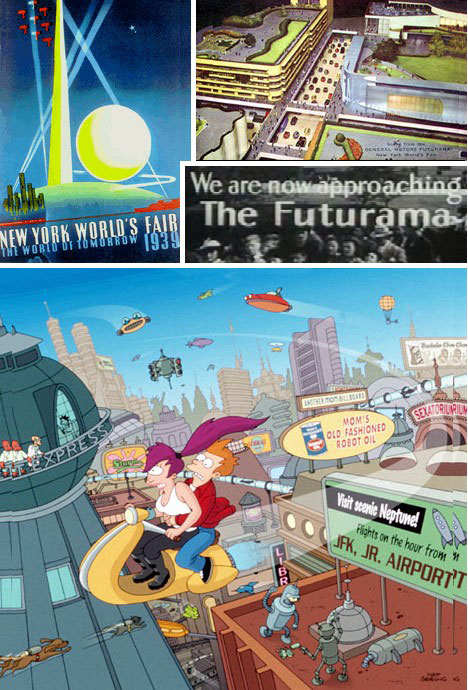 (images via: David S Zondy and Katsclass)
(images via: David S Zondy and Katsclass)
Then there’s Futurama, the animated cartoon beloved by kids, geeks and kid-geeks. How many know that an earlier Futurama – about six decades earlier – took a stab at predicting urban life in the future. The 1939 New York World’s Fair set its sights somewhat more modestly, however, pegging 1960 as the year in which radio-controlled cars zipped along broad-shouldered highways and disc shaped airports rotated on captive oil slicks.
Just Off the Asteroid Beltway
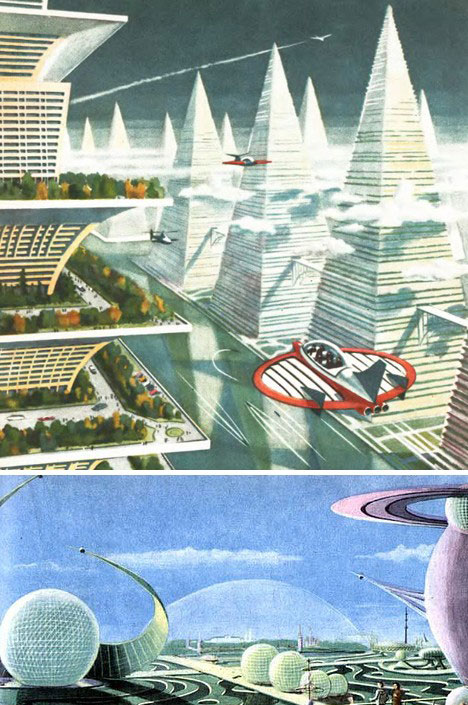 (image via: Dark Roasted Blend)
(image via: Dark Roasted Blend)
Our conception of space exploration envisions pioneering probes followed by colonization and settlement once suitable planets are found. What will it be like? Over the years, artists and graphic designers have provided tantalizing glimpses of our far-flung future.
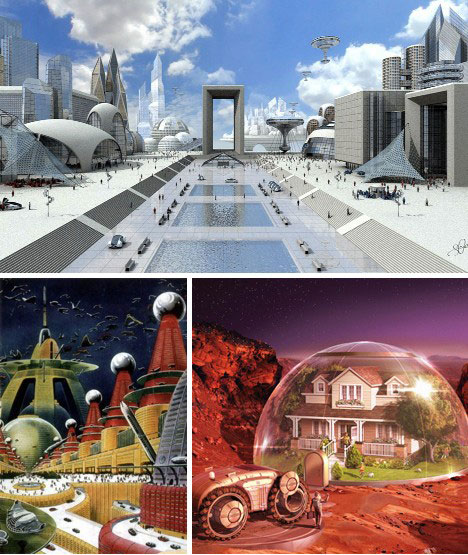 (images via: Cutlery News Journal and Radio Open Source)
(images via: Cutlery News Journal and Radio Open Source)
Indeed, true futuristic living means leaving the planet altogether, especially if An Inconvenient Truth should become a reality. Whether your descendants will make their homes just off the Asteroid Beltway or rent a bachelor pad in the Galactic Arms matters not – what’s important is that we know what to expect once we break the surly bonds of Earth to surely brake our rocket engines amongst the stars.